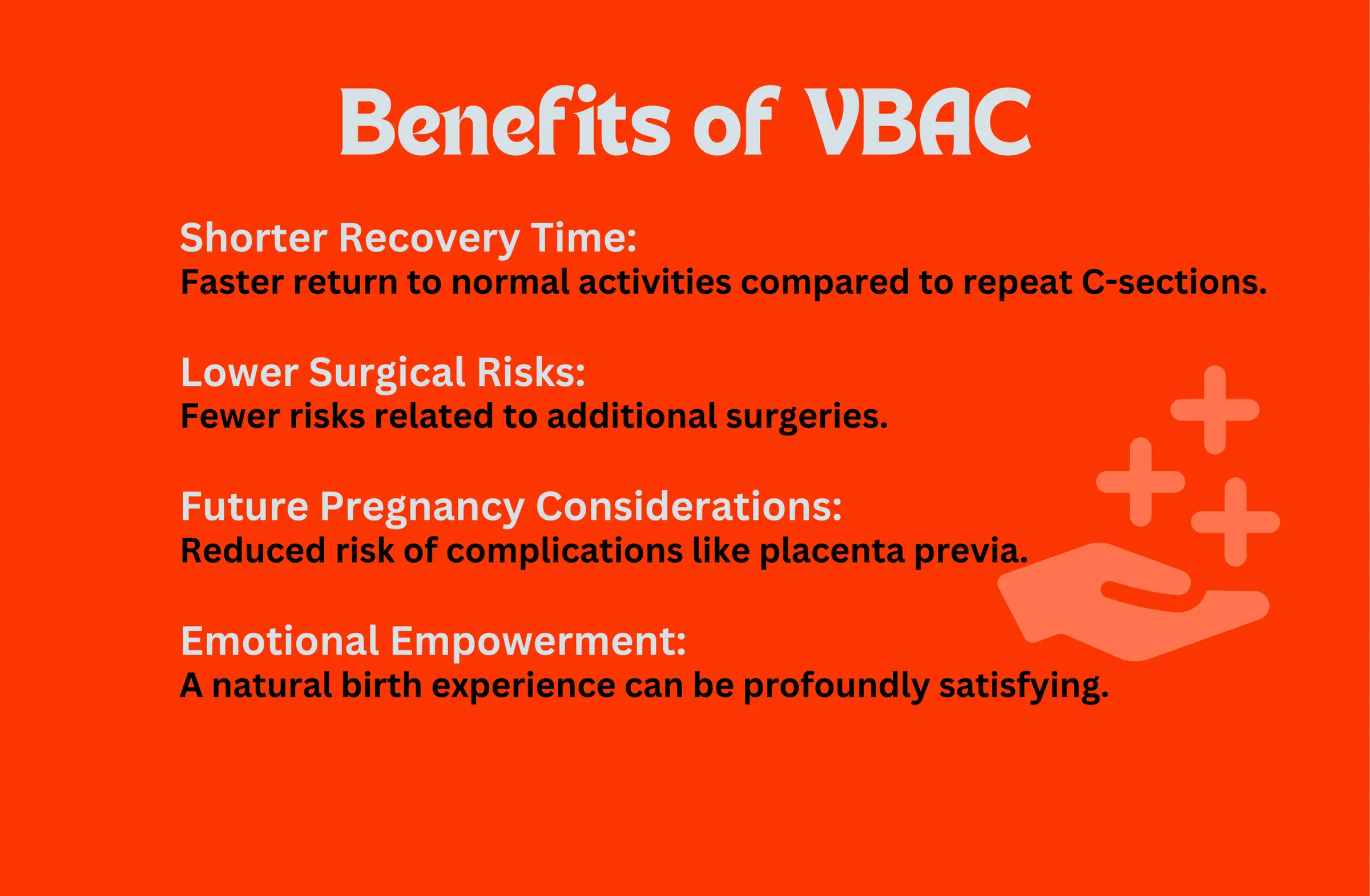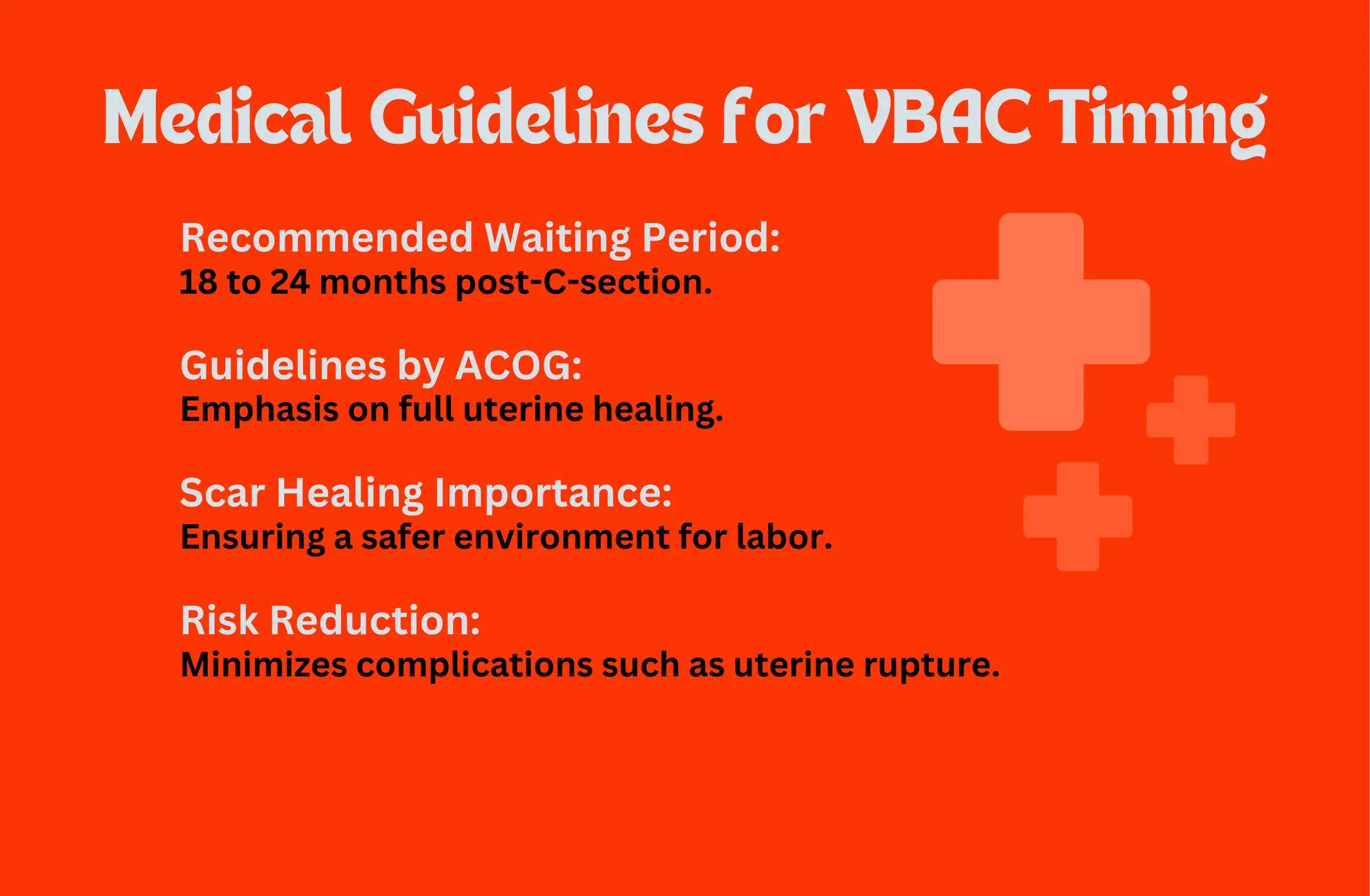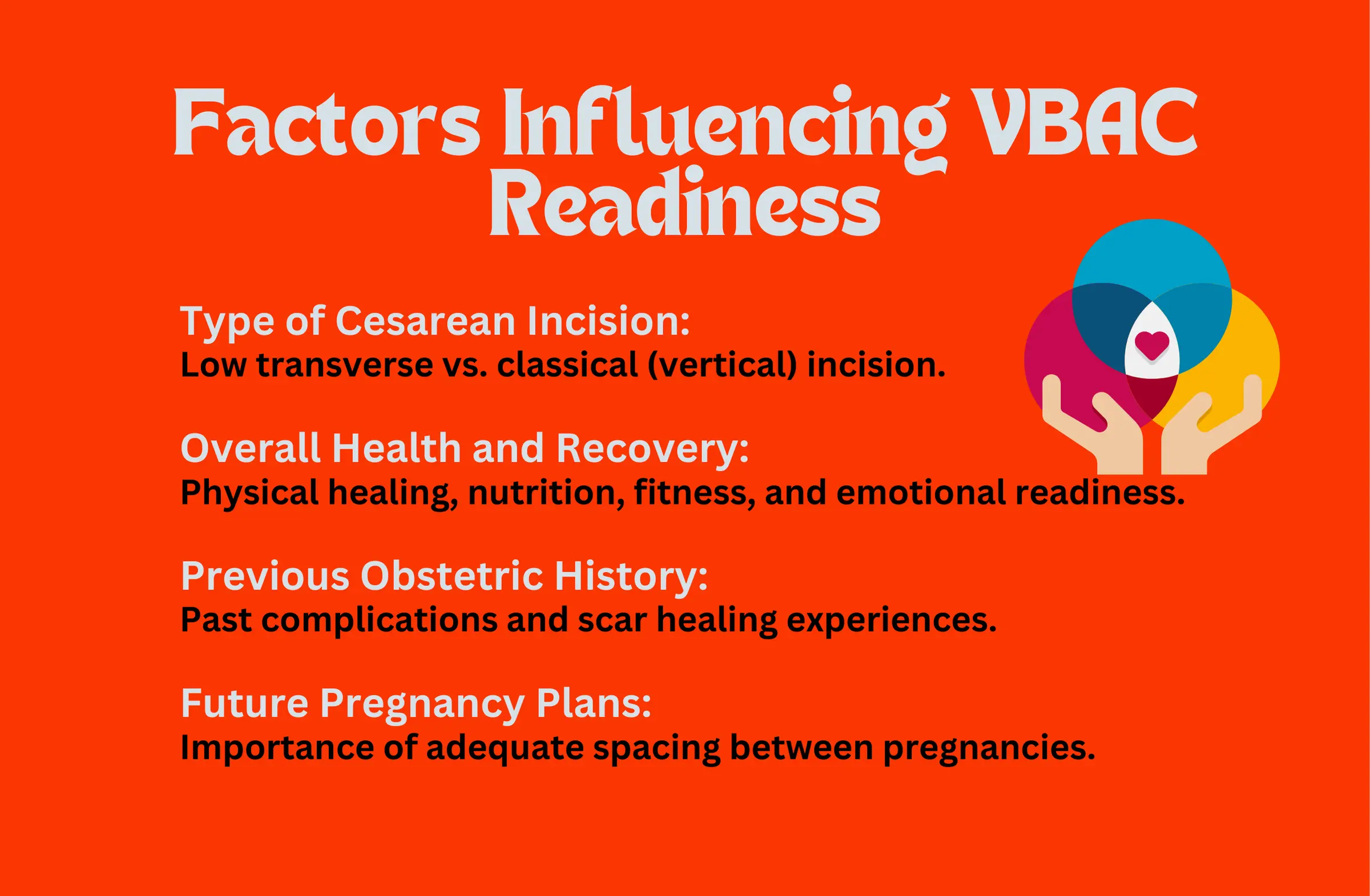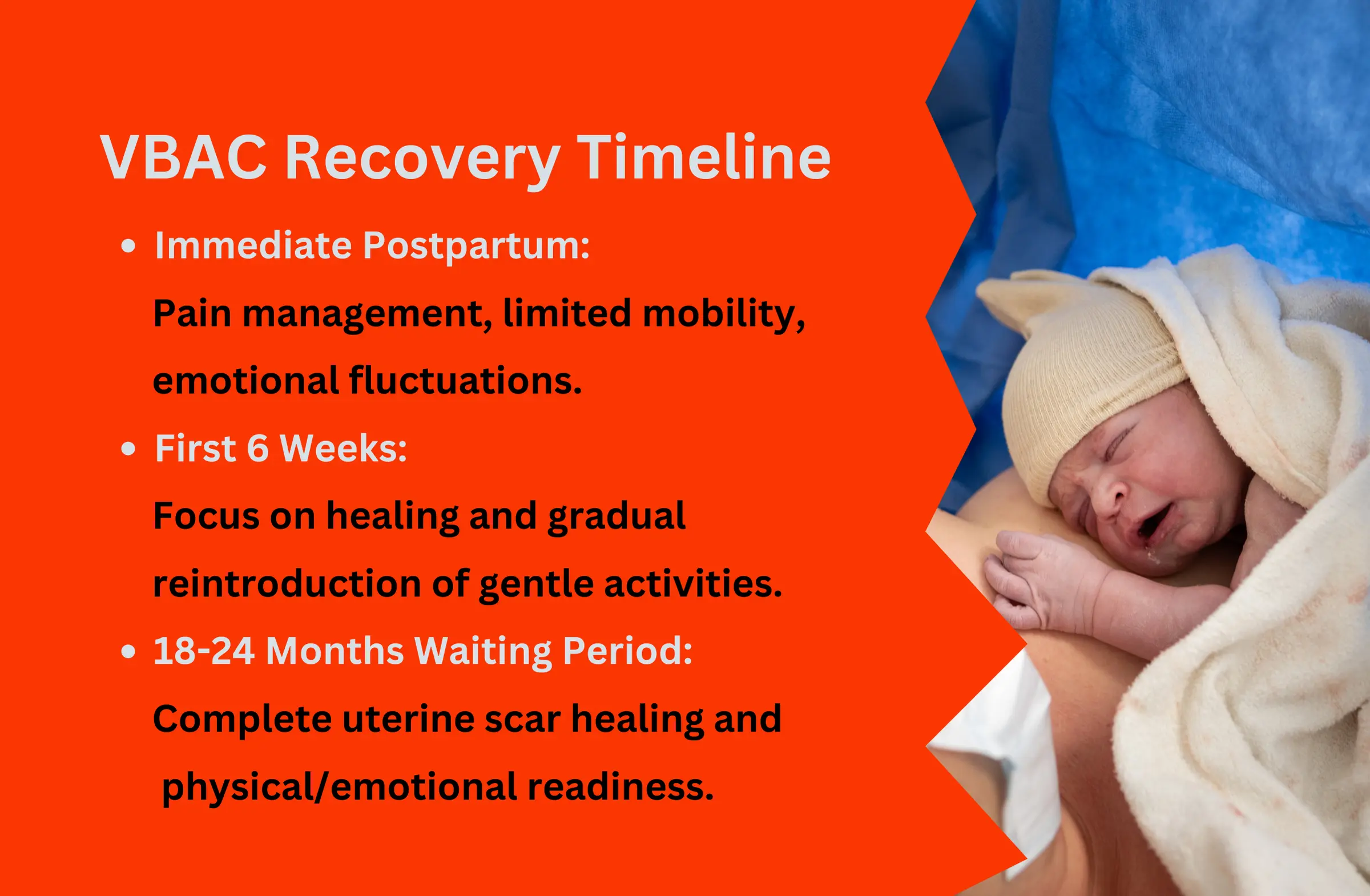Deciding to have a vaginal birth after a cesarean (VBAC) is an empowering choice, but one of the most common questions that arises is: how long after a C-section can you have a VBAC? In this comprehensive guide, I’ll walk you through everything you need to know about planning a VBAC after a cesarean delivery. We’ll delve into medical guidelines, discuss factors influencing timing, cover recovery considerations, and share practical tips to help you prepare both physically and emotionally for a safe VBAC experience. Whether you’re actively considering VBAC or simply gathering information for future decisions, this guide is designed to empower you with knowledge and actionable advice.
Introduction
After a cesarean section, many women start exploring their options for future births. VBAC—a vaginal birth after cesarean—offers potential benefits such as a shorter recovery time and a more natural birthing experience. However, a critical aspect of planning a VBAC is understanding how long after a C-section can you have a VBAC?
I remember the countless discussions I had with my OB-GYN when I first considered VBAC. My concerns ranged from scar healing to overall readiness for labor. It became clear that the optimal waiting period varies depending on individual factors like your health, the type of cesarean incision, and overall recovery progress.
In this guide, we will break down current medical guidelines, discuss key factors that influence the waiting period, and offer practical tips for preparing for a successful VBAC.
What Is VBAC?
VBAC stands for Vaginal Birth After Cesarean. It refers to delivering a baby vaginally after having had a previous cesarean section. Many women choose VBAC to avoid the risks and longer recovery associated with multiple C-sections.
Benefits of VBAC
Some of the potential advantages of VBAC include:
- Shorter Recovery: Vaginal births generally result in a quicker recovery compared to cesarean deliveries.
- Lower Surgical Risks: Avoiding additional surgeries reduces the risk of complications such as infections, heavy bleeding, or adhesions.
- Future Pregnancy Considerations: A VBAC may lower the risk of complications like placenta previa or placenta accreta in future pregnancies.
- Emotional Satisfaction: Many women report a sense of empowerment and satisfaction from experiencing a natural birth.
Ultimately, the decision to attempt a VBAC should be made in close consultation with your healthcare provider, weighing both the benefits and the potential risks.

Medical Guidelines on VBAC Timing
One of the most critical questions is: how long after a C-section can you have a VBAC? Medical guidelines generally recommend an interpregnancy interval of at least 18 to 24 months. This waiting period is intended to allow the uterine scar to heal adequately, which significantly reduces the risk of complications like uterine rupture during labor.
According to the American College of Obstetricians and Gynecologists (ACOG), waiting at least 18 to 24 months after a C-section before attempting a VBAC is strongly recommended for the best outcomes for both the mother and the baby. This guideline is backed by extensive research indicating that a longer recovery time improves uterine healing and reduces labor complications.

Factors Influencing the Waiting Period
While the 18 to 24-month guideline is common, several factors can influence your personal waiting period before attempting a VBAC:
Type of Cesarean Incision
- Low Transverse Incision: This horizontal cut in the lower uterus is the most common and is considered the safest for VBAC because it has a lower risk of rupture.
- Classical (Vertical) Incision: This less common incision type carries a higher risk of complications, and many healthcare providers may advise against a VBAC if this method was used.
Women with a low transverse incision typically have more flexibility regarding timing, whereas those with a vertical incision might be advised to wait longer or may be discouraged from attempting a VBAC.
Overall Health and Recovery
Your overall recovery from the C-section plays a vital role. Consider these factors:
- Physical Recovery: How well your body has healed from surgery, including the repair of the uterine scar.
- Nutritional Status: Adequate nutrition is essential for tissue repair.
- Fitness Level: Regular physical activity and a healthy weight can aid in faster recovery.
- Emotional Readiness: Mental and emotional recovery is equally important as physical healing.
Previous Obstetric History
Your previous pregnancy outcomes, complications, and overall reproductive history may influence your readiness for a VBAC. For instance, if you had complications in your past C-section or if there were issues with scar healing, your provider may recommend a longer waiting period.
Future Pregnancy Plans
If you plan to have more children, spacing your pregnancies appropriately is important. Adequate time between pregnancies not only improves scar healing but also minimizes risks for subsequent births.

Recovery After a C-Section: What to Expect
Understanding your recovery timeline post-C-section is essential in planning for a VBAC.
Immediate Postpartum Period
Immediately after a C-section, you can expect:
- Pain and Discomfort: Incision pain is managed with prescribed pain relievers.
- Limited Mobility: You’ll need to take it easy as your body starts to heal.
- Emotional Fluctuations: It’s normal to experience a range of emotions, from joy to anxiety, in the immediate postpartum period.
The First Six Weeks
During the first six weeks, your focus should be on recovery. This period is critical for the healing of the uterine scar and overall physical recovery. You’ll likely be advised to avoid strenuous activities and gradually ease back into exercise as your body allows.
The First 18-24 Months
The waiting period of 18 to 24 months after a C-section is designed to ensure that your body has fully healed and is ready for the rigors of labor. This time frame allows for:
- Complete Scar Healing: Providing a safer environment for labor.
- Physical Strength Recovery: Rebuilding the strength needed for a vaginal birth.
- Emotional Readiness: Giving you time to reflect and prepare mentally for another birth experience.

Preparing for a VBAC: Tips for a Successful Vaginal Birth After Cesarean
Once you’ve reached the recommended waiting period and are considering a VBAC, there are several proactive steps you can take to optimize your chances of a safe and successful vaginal birth.
Prenatal Care and Communication
Regular prenatal visits are essential. Your healthcare provider will monitor your recovery and assess the integrity of your uterine scar. Open communication with your provider is key:
- Discuss Your VBAC Plan: Share your desire for a VBAC and ask questions about any concerns you may have.
- Monitor Progress: Regular check-ups and imaging tests can help confirm that your body is healing as expected.
Creating a Comprehensive Birth Plan
Developing a detailed birth plan can help ensure that your preferences are respected during labor. Consider:
- Pain Management: Explore options such as epidurals, natural pain relief techniques, or a combination.
- Labor Preferences: Outline your wishes regarding interventions, monitoring, and support.
- Support System: Decide who will be by your side during labor—be it your partner, a doula, or a close family member.
Lifestyle and Fitness
Maintaining a healthy lifestyle is crucial during your recovery and in preparation for VBAC:
- Regular Exercise: Engage in gentle exercises like walking, swimming, or prenatal yoga to rebuild strength and stamina.
- Balanced Nutrition: A nutrient-rich diet supports healing and provides the energy needed for labor.
- Stress Management: Techniques such as meditation and deep breathing can reduce anxiety and promote a positive outlook.
Emotional and Psychological Preparation
VBAC is not just a physical journey—it’s an emotional one, too:
- Mindfulness Practices: Consider mindfulness, meditation, or counseling to help manage stress and build confidence.
- Support Groups: Joining a VBAC support group can provide insights from other women who have navigated similar journeys.
- Educate Yourself: Knowledge is power; attend prenatal classes focused on VBAC and stay informed about the latest guidelines.
The Role of Nutrition and Exercise in VBAC Preparation
A healthy body is key to a successful VBAC. Focus on these lifestyle factors:
- Balanced Diet: Incorporate lean proteins, whole grains, fruits, and vegetables. Nutrients like vitamin D, calcium, and omega-3 fatty acids are important for healing.
- Hydration: Drink plenty of water to support tissue repair and overall health.
- Physical Activity: Gentle exercises can help rebuild strength and improve circulation. Always consult your healthcare provider before starting any new exercise program.
Psychological and Emotional Preparation
The journey to a successful VBAC also requires emotional readiness:
- Mindfulness and Meditation: Regular practice can help reduce anxiety and prepare you mentally for labor.
- Counseling: Speaking with a counselor or therapist can provide support and help manage any fears or concerns.
- Visualization Techniques: Many women find that visualizing a positive birth experience can reduce anxiety and enhance confidence.
Expert Perspectives on VBAC Timing
Expert recommendations underscore the importance of waiting at least 18 to 24 months after a C-section before attempting a VBAC. According to the American College of Obstetricians and Gynecologists (ACOG), this waiting period allows the uterine scar to heal completely and significantly lowers the risk of complications such as uterine rupture. Dr. Sarah Thompson, a maternal-fetal medicine specialist, explains that adequate healing time is critical for ensuring both maternal and fetal safety during a VBAC.
Coordinated Care: Working with Your Healthcare Team
A successful VBAC journey relies on coordinated care between multiple healthcare professionals:
- OB-GYNs: Your primary provider will oversee your pregnancy and monitor your progress.
- Maternal-Fetal Medicine Specialists: For high-risk cases, these specialists offer additional expertise.
- Midwives and Doulas: Their support can help create a more natural, less medicalized birth experience.
- Physical Therapists: Postpartum therapy can aid in recovery and strengthen core muscles.
Open communication with your healthcare team is essential for tailoring a VBAC plan that meets your unique needs.
Innovations and Future Directions in VBAC Research
The field of VBAC is continually evolving. Ongoing research is focusing on:
- Advanced Diagnostic Techniques: New imaging methods aim to assess uterine scar integrity more accurately.
- Personalized Treatment Protocols: Future guidelines may be tailored based on individual genetic and health profiles.
- Integrative Pain Management: Innovations in non-pharmacological pain relief could enhance the VBAC experience.
- Digital Health Solutions: Telemedicine and mobile apps are increasingly being used to support VBAC planning and monitoring.
Staying informed about these developments can help you and your healthcare provider choose the best possible strategy for your VBAC journey.
Preventive Measures and Long-Term Health Considerations
Even after a successful VBAC, long-term health and preventive measures remain essential:
- Regular Medical Check-Ups: Continue with routine prenatal and postpartum appointments to monitor your overall health and the integrity of your uterine scar.
- Healthy Lifestyle: Maintain balanced nutrition, regular exercise, and stress management practices.
- Family Planning: If planning future pregnancies, ensure adequate spacing to support healing and reduce risks.
- Education and Support: Continue to educate yourself and participate in support groups to stay updated on best practices and share experiences.
Real-Life Stories: Testimonials from Women Who Chose VBAC
Throughout my research, I’ve spoken with many women who have successfully navigated their VBAC journeys. One mother described her VBAC as a transformative experience after waiting 24 months post-C-section. Her journey was filled with thorough prenatal care, a comprehensive birth plan, and the support of a dedicated medical team. Another woman, initially anxious about the safety of VBAC, found reassurance through joining a VBAC support group and attending specialized prenatal classes. Her positive experience reinforced the importance of patience, preparation, and a supportive healthcare network.
These testimonials illustrate that while every VBAC journey is unique, a well-planned approach and proper waiting period can lead to a safe and empowering birth experience.
Addressing Common Concerns About VBAC
It’s natural to have concerns when planning a VBAC. Here are some frequently asked questions and insights:
- Is it safe to have a VBAC after a C-section?
Yes, VBAC is generally safe for many women, particularly those with a low transverse incision. Safety depends on individual health, recovery progress, and adherence to recommended waiting periods. - How long should I wait after a C-section before attempting a VBAC?
Most experts suggest waiting at least 18 to 24 months to allow for full uterine healing. This interval significantly reduces the risk of uterine rupture and other complications. - What are the risks of attempting a VBAC too early?
Attempting a VBAC before complete healing increases the risk of uterine rupture and other complications, which can impact both maternal and fetal health. - How can I prepare for a successful VBAC?
A successful VBAC requires comprehensive preparation, including regular prenatal care, a healthy lifestyle, a well-developed birth plan, and strong emotional support. Educating yourself and engaging with a supportive healthcare team is essential.
Coordinated Care and Multidisciplinary Support
Working with a comprehensive healthcare team is key to a positive VBAC experience:
- OB-GYNs and Maternal-Fetal Medicine Specialists: Regular consultations ensure that your recovery is on track and your VBAC plan is safe.
- Midwives and Doulas: Their expertise in natural birth processes can enhance your VBAC experience.
- Support Networks: Engaging with other VBAC moms through support groups can offer invaluable insights and encouragement.
This coordinated approach helps ensure that you receive personalized care tailored to your unique needs, making your VBAC journey as smooth as possible.
Future Research and Innovations in VBAC
The landscape of VBAC is evolving rapidly, with ongoing research focused on improving outcomes and personalizing care. Areas of emerging interest include:
- Improved Diagnostic Imaging: New techniques to assess uterine scar integrity may allow for more accurate predictions of VBAC success.
- Personalized Medicine: Tailoring VBAC recommendations based on individual health metrics could further enhance safety.
- Integrative Pain Management: Research into alternative pain relief methods, including acupuncture and mindfulness, offers promising avenues for a less stressful labor experience.
- Digital Health Integration: Telemedicine and mobile applications are becoming valuable tools in monitoring and planning VBAC, ensuring continuous care and support.
These innovations are set to transform VBAC protocols and may offer even more effective, individualized treatment plans in the near future.
Conclusion: Empower Yourself for a Successful VBAC
Deciding to have a VBAC after a C-section is a personal and empowering choice that requires careful planning, patience, and a comprehensive approach to recovery. By understanding the recommended waiting period—typically at least 18 to 24 months—monitoring your recovery, and preparing both physically and emotionally, you can significantly increase your chances of a safe and successful vaginal birth after cesarean.
I hope this extensive guide has provided you with valuable insights and practical advice to help you on your VBAC journey. Remember, every woman’s experience is unique, and the key is to work closely with your healthcare team to develop a plan that suits your individual needs. Empower yourself with knowledge, trust your body’s healing process, and take proactive steps toward achieving your VBAC goals.
According to the American College of Obstetricians and Gynecologists (ACOG), waiting at least 18 to 24 months after a C-section is crucial for optimal healing and safety, while Mayo Clinic emphasizes the importance of regular prenatal care and a supportive healthcare team in ensuring a successful VBAC.
FAQs
-
How long should I wait after a C-section before attempting a VBAC?
Most experts recommend waiting at least 18 to 24 months to allow your uterine scar to heal fully, reducing the risk of complications.
-
What factors determine my eligibility for a VBAC?
Factors include the type of C-section incision, your overall health, recovery progress, previous pregnancy history, and any complications experienced.
-
Is VBAC safe for everyone after a C-section?
VBAC is generally safe for women with a low transverse incision and who meet other health criteria. However, it’s essential to consult your healthcare provider to determine if it’s the right option for you.
-
What can I do to prepare for a successful VBAC?
Preparation includes regular prenatal care, maintaining a healthy lifestyle, creating a detailed birth plan, and building a strong support network.
-
What are the risks of attempting a VBAC too early?
Attempting a VBAC before full healing can increase the risk of uterine rupture and other complications, which is why the recommended waiting period is crucial.
-
How does a coordinated healthcare team improve VBAC outcomes?
A multidisciplinary team ensures comprehensive care, from monitoring uterine scar healing to providing emotional support and personalized birth planning, thereby enhancing the overall safety and success of VBAC.